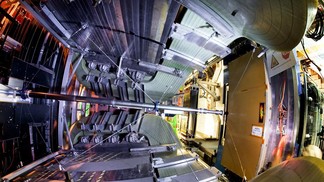Mar 3 2014
As members of the LHCb collaboration, scientists at EPFL have analyzed data collected at CERN’s Large Hadron Collider that offer a first-time observation of the polarization of the photon emitted in the weak decay of a bottom quark. This finding opens the way to future measurements, which may reveal a reality deeper than the one described by the present theory of elementary particles, the so-called Standard Model.
 © 2014 CERN-LHC
© 2014 CERN-LHC
Elementary particles, like photons, have a property called spin. If the particle is imagined as a spinning top, its spin refers to its angular momentum – the measure of how much rotation the particle has. For photons, this rotation can be either clockwise or counter-clockwise, and the photons are said to be either “left-” or “right-handed”. The measure of how much it is left-handed or right-handed is called “polarization”. The Standard Model, which also predicted the existence of the Higgs boson, includes a precise prediction of this phenomenon. Working in the LHCb collaboration, EPFL scientists have observed a non-vanishing polarization, which means that the photon is preferentially left-handed or right-handed. This represents a first step towards a new way of searching for physics beyond the Standard Model.
The Standard Model is a theory that, so far, can successfully describe all known phenomena between elementary particles, including the Higgs boson discovered in 2012 at the LHC. According to the Standard Model, the elementary constituents of matter are either leptons (such as the electron or the neutrino) or quarks. There are six types (or “flavors”) of quarks: down, up, strange, charm, bottom, and top.
Quarks can transform from one flavor to another, e.g. through the ‘beta decay’ of some unstable atoms. Another example is the transformation of a bottom quark into a strange quark through the emission of a very energetic photon. In this case, the Standard Model predicts that the photon should be almost always left-handed. However, such a photon polarization has never before been observed directly.
Now, the group of Olivier Schneider at EPFL has analyzed data recorded in 2011 and 2012 with the LHC “beauty” detector. By measuring a physics quantity that is proportional to photon polarization, the team found that when a bottom quark decays into a strange quark and emits a photon, that photon is polarized. This is what the particle physics community refers to as an "observation": the chances of it being the result of statistical error is less than one in three million.
“Our observation opens the way to a future measurement of the photon polarization, which will be a test of the Standard Model or, equivalently, a search for entirely new physics effects”, says Olivier Schneider. “Indeed, if new particles or new forces exist and interfere with the Standard Model process, the photon may not be almost purely left-handed.”